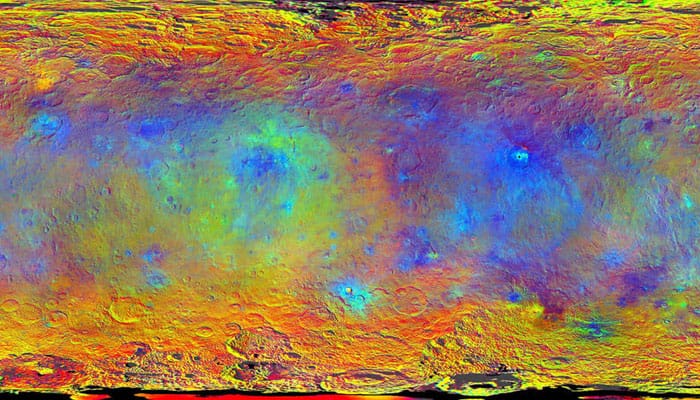Washington: NASA's Dawn spacecraft continued to amaze, yet puzzle scientists with its tantalizing views and other data about the dwarf planet Ceres.
The space probe, which has been orbiting Ceres since March, has produced a multitude of images, spectra and now energetic particle bursts that may have been produced by interactions between the dwarf planet and solar radiation.
A new color-coded topographic map shows more than a dozen recently approved names for features on Ceres, all eponymous for agricultural spirits, deities and festivals from cultures around the world.
Another new Ceres map, in false color, enhances compositional differences present on the surface. The variations are more subtle than on Vesta, Dawn's previous port of call. Color-coded topographic images of Occator (oh-KAH-tor) crater, home of Ceres' brightest spots, and a puzzling, cone-shaped 4-mile-high (6-kilometer-high) mountain, are also available.
Scientists are still trying to identify processes that could produce these and other unique Cerean phenomena.
“The irregular shapes of craters on Ceres are especially interesting, resembling craters we see on Saturn's icy moon Rhea,” said Carol Raymond, Dawn's deputy principal investigator based at NASA's Jet Propulsion Laboratory, Pasadena, California. “They are very different from the bowl-shaped craters on Vesta.”
The new Ceres maps are being discussed this week at the European Planetary Science Conference in Nantes, France.
Dawn is currently orbiting Ceres at an altitude of 915 miles (1,470 kilometers), and the spacecraft will image the entire surface of the dwarf planet up to six times in this phase of the mission.
Dawn made history as the first mission to reach a dwarf planet, and the first to orbit two distinct extraterrestrial targets, when it arrived at Ceres on March 6, 2015. It conducted extensive observations of Vesta in 2011 and 2012.
















